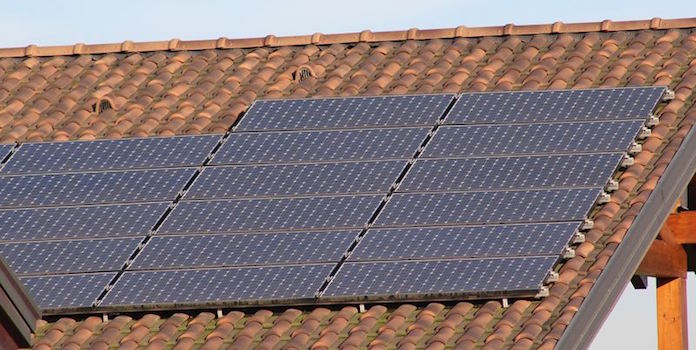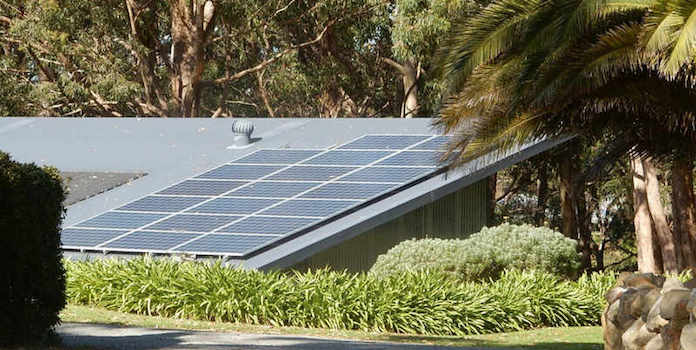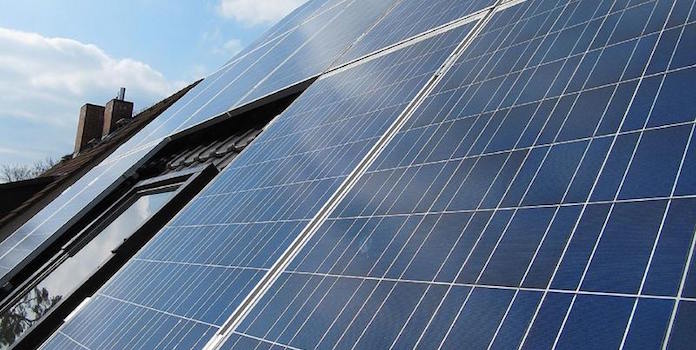How Big and Expensive is a 5kW Solar System?

An average-sized installation for the average home.
Residential solar installations run from a measly 2kW to a monstrous 25kW (or even bigger). Twenty-five kilowatts (kW) is a huge solar installation (at least for residential projects), equal to about 100 solar panels.
Don’t have that much space on your roof? Don’t worry! Most installations, such as the 5kW solar system, are well below that size. Most of us don’t even use enough electricity to warrant an installation that big! In fact, according to the National Renewable Energy Lab (p.5), the average installation is about 5.6kW.
Today, let’s take a peek at a 5kW installation to understand exactly how big that is, how much you can expect to pay for one, and how much you can save by installing a system of this size.
Efficiency first!
Before we get into the details of a 5kW installation, here’s a secret to help you save big bucks: before starting any solar project, take some simple steps to lower your overall energy use. Replace light bulbs with LEDs, add insulation if needed, and seal up air leaks around your doors and windows.
Believe it or not, efficiency measures are actually a cheaper way to save money than installing solar! And with your lower electricity use, you’re able to install a smaller solar installation, thereby saving you even more. So if you’re thinking about solar, remember efficiency first!
Don’t know where to start? Have an energy audit performed on your home. During this process, a tech tours your house and notes any place where you’re wasting electricity. At the end of the audit, they’ll give you a prioritized list of actions that can lower your energy use.
These audits can be a little expensive (a couple hundred bucks for the full-blown edition), but utilities often provide discounts for them, so hop on your utility’s website to see what they offer.
How big is a 5kW solar system?
Alright, let’s get down to business. First, let’s take a look at exactly how big a 5kW installation really is.
What does 5kW actually mean?
A 5kW solar installation produces 5 kilowatts of electricity under perfect conditions. With LED light bulbs using about 9 watts (or .009 kilowatts), a 5kW installation could power 555 LEDs indefinitely – as long as perfect conditions remained 24/7 (5000 watts / 9 watts = 555 LEDs).
Over the course of an hour, one 9 watt LED uses 9 watt-hours of electricity. A 5kW solar installation, under perfect conditions, produces 5 kilowatt-hours (kWh) over the course of an hour, under perfect conditions. Over 10 hours, it produces 50 kWh.
In reality, we aren’t lucky enough to have perfect conditions. The sun goes down each night. Storms come in. Rain pours down. Some places, like Washington and New York, just don’t enjoy the same ultra-strong sunlight than Arizona and Nevada do.
In reality, your solar installation will produce less than its nameplate capacity. Exactly how much will depend on your location. The National Renewable Energy Lab’s PVWatts solar calculator gives us a glimpse into what we can expect a 5kW installation to produce over a year in different areas of the US. Let’s take a look:
- Anchorage, AK: 4,487 kWh/year
- Pittsburgh, PA: 6,085 kWh/year
- Lexington, KY: 6,592 kWh/year
- Miami, FL: 7,331 kWh/year
- Reno, NV: 8,371 kWh/year
A 5kW solar installation in Reno, NV, (one of the best states for solar) produces almost 2x more electricity annually than the same installation in Anchorage, Alaska! That’s obviously a pretty extreme example – installations contained within the contiguous US are much more similar. You can see that Pittsburgh, PA, only produces about 30% less than Reno.
The average home in the US uses about 10,800 kWh of electricity each year, so a 5kW installation will cover about 40% to 80% of the average home’s energy use (again, depending on location). Whether or not an installation of this size would cover your own energy use depends on how much electricity you use each year, and how much a 5kW solar installation produces in your area.
How many solar panels is that?
The typical residential solar panel produces about 265 watts (or .265 kilowatts). Yingli Solar, for example, produces residential solar panels in their popular YGE 60 Cell Series from 250 to 275 watts. At 265 watts, you’d need 19 solar panels to make up 5kW.
Premium, high-efficiency solar panels produce more electricity, so you’re able to install fewer panels – particularly useful if your roof is small. SolarWorld produces some of the best solar panels on the market, and their Sunmodule Plus enjoy a capacity up to 300 watts. At 300 watts, you’d need only 17 panels – saving about 30 square feet on your roof.
Speaking of roof space, just how much does a 5kW solar installation take up? Let’s take a look!
How much space does that take on my roof?
Residential solar panels are typically about 5 feet tall by 3 feet wide (65”x39” to be even more precise), equaling about 15 feet square. The 19 panels from our example above would total 285 square feet. If you went with the more efficient 17 panels, you’re looking at about 255 square feet – equal to a dorm room or (very) small studio apartment.
If you’re worried that you don’t have enough roof space for 285 square feet of solar panels, fear not! Most of us have plenty of space on our roofs for a solar installation of this size. As we already mentioned, the average solar installation in the US is actually a bit bigger than 5kW!
Most solar installations in the US use string inverters. These are inexpensive and reliable, but there are downsides: all your solar panels need to face the same direction and angle (roof tilt) to work properly. If you don’t have that much open space on your roof, there are ways to get around this.
First, there are special inverters out there that allow you to break up your solar panels into two groups (one group on a south-facing section of your roof, one on an east-facing section for example), allowing you to use different roof sections facing in separate directions and with different tilt angles.
If you’ve got multiple, smaller roof sections (like many new homes), you’re not out of luck just yet! Using microinverters under each solar panel instead of one string inverter allows you to install all your solar panels in different directions, as each panel is optimized individually. This allows you to install panels all over your roof – even if a section can only handle 2 or 3 panels.
How expensive is a 5kW solar system?
The price of installing solar has decreased dramatically over the last 10 years. What was once prohibitively expensive is now something most of us can easily afford – especially with all the different financing options out there!
Installing solar now costs about $3 per watt, 60% less than just 8 years ago in 2009! At this rate, your 5kW installation costs about $15,000. Compare that to $35k in 2009 and you can see just how far we’ve come.
Throwing in the 30% federal tax credit, your total investment drops to an astonishingly-low $10,500. You might even be eligible for additional state, local, or utility incentives to drop that cost even further. Check our state guides to see what additional benefits you qualify for.
How much money you can actually save with a 5kW installation depends on 2 things: your solar installation’s electricity production (i.e. your location, like we described above), and your utility’s electricity prices. The more your utility charges, the more you save by avoiding those prices and producing your own electricity!
We’ve already looked at a few locations above, so let’s do the math for a couple of them:
Anchorage, AK
- Solar Production: 4,487 kWh/year, dropping 0.8% annually due to degradation (p.6)
- Average Electricity Cost: $0.22 per kWh, 3.7% annual increase
- Total Savings: $20,866
As we already know, solar installations don’t produce nearly as much electricity in Alaska as in other areas of the US. However, Alaskan residents suffer from some of the highest electricity rates in the country, so they can still save quite a bit!
If you purchased 4,487 kWh (with an annual 0.8% drop) each year over the next 25 years (the estimated life of most solar installations) at the average utility cost in Alaska, you’d pay a total of $35,866. Yikes!
With the average solar installation costing about $15,000, Alaskans are able to save about $20k in total by installing a 5kW system ($35,866 – $15,000 = $20,866). Not a bad deal, huh?
If we accounted for the federal tax credit (which we didn’t), savings would actually be closer to $25k!
As we mentioned, though, electricity prices in Alaska are sky-high, so let’s take a look at a state with electricity prices closer to what most of us experience.
Pittsburgh, PA
- Solar Production: 6,085 kWh/year
- Average Electricity Cost: $0.14 per kWh, 2.6% Annual Increase
- Total Savings: $11,530
With the average utility charging about $0.14 per kWh in Pennsylvania and raising rates 2.6% each year, you’d spend $26,530 over the next 25 years purchasing 6,085 kWh each year. Solar production in Pennsylvania isn’t spectacular by any means, and even with electricity prices being quite average (just a penny more than the national average), you can save about $11,500 by installing solar!
These savings are pretty great, right? If you don’t take our word for it, open up Microsoft Excel and do the math yourself! All our sources are publicly available from the federal government, so open up the links above and get to work. I think you’ll like what you find!
Installing a 5kW solar installation isn’t going to break the bank (especially with all the financing available now) and can save you quite a bit over its lifetime. It’s not a gigantic system, but many homeowners find it nearly the perfect size for their needs.
Interested in reading about bigger systems? Check out our article on 20kW installations! How about smaller? Read up on 3kW installations as well.
Have questions on system size? Ask away in the comments!
Image Credit under CC License via Pixabay – 1, 3 & Flickr – 2


